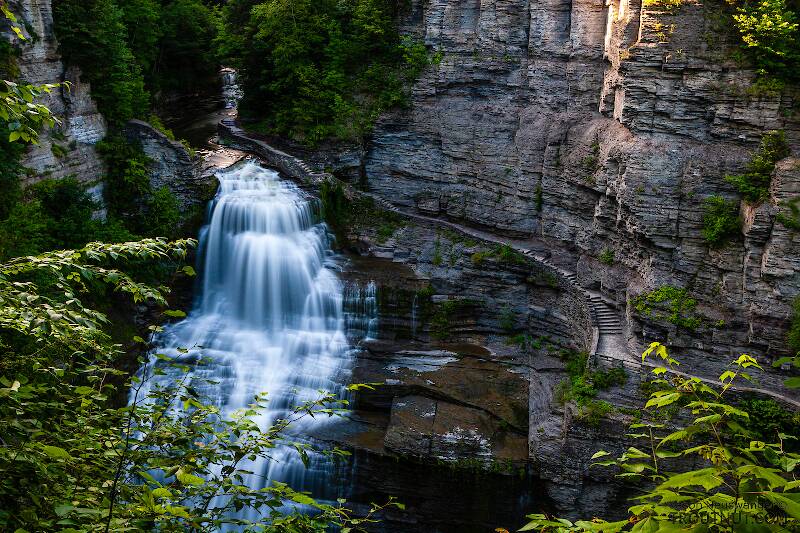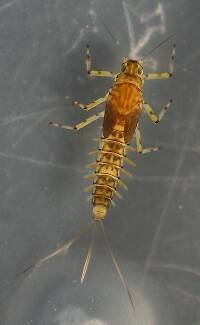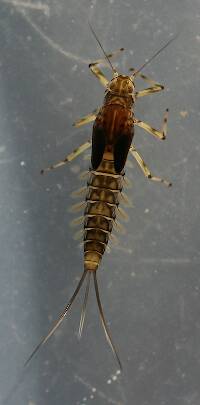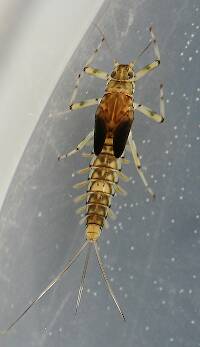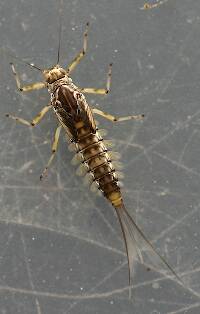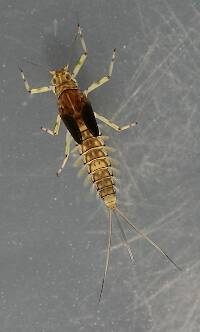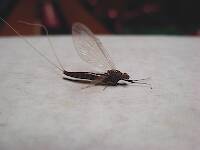
Salmonflies
Pteronarcys californica
The giant Salmonflies of the Western mountains are legendary for their proclivity to elicit consistent dry-fly action and ferocious strikes.
Featured on the forum
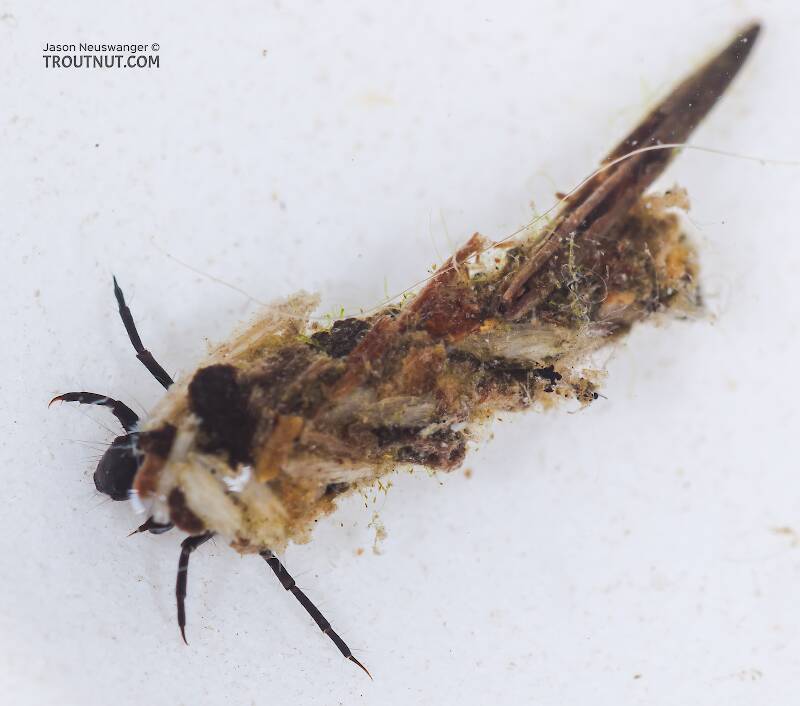
This seems to be a young larva of Limnephilus. Although not clear in the picture, several ventral abdominal segments have chloride epithelia.

Troutnut is a project started in 2003 by salmonid ecologist Jason "Troutnut" Neuswanger to help anglers and
fly tyers unabashedly embrace the entomological side of the sport. Learn more about Troutnut or
support the project for an enhanced experience here.
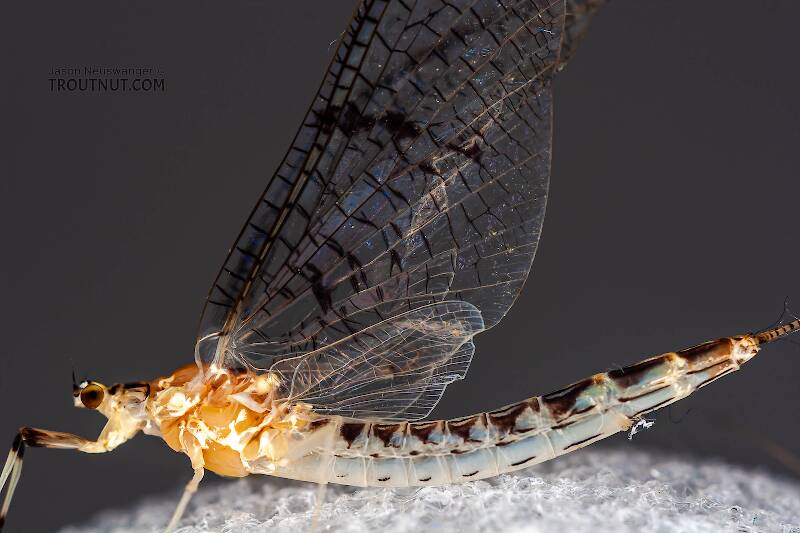
I found this female spinner ovipositing in a small stream. She came along while I was playing a trout -- every good bug seemed to do that last night! I didn't have my bug net, so I caught the trout in my landing net, released the trout, and caught the mayfly in my landing net. Her wing got a bit messed up from that.
Taxon on Jul 10, 2006July 10th, 2006, 2:47 pm EDT
Not sure who (originally) came up with a 13-16 mm. length range for Ephemera varia spinners, but I'm suspecting each subsequent author must have just parroted it. Your specimen appears to be 19 mm. in length, and there is certainly no doubt concerning its identity.
GONZO on Sep 13, 2006September 13th, 2006, 5:07 am EDT
I agree with Taxon that the size range for the yellow drake is regularly underestimated. On the Yellow Breeches, they typically range 16-18mm for the males and 17-20mm for the females. All of the large burrowers are quite variable in length, and the size of brown drakes (E. simulans) is similarly underestimated in some texts. My largest specimens of varia are from large limestone waters (like the Breeches), and the largest simulans specimens were found in lake-dwelling populations.
On a related note, I find that the size range of slate drakes (I. bicolor) is also frequently low-balled.
I have collected specimens of all three species that were in the (+/-)20mm range.
On a related note, I find that the size range of slate drakes (I. bicolor) is also frequently low-balled.
I have collected specimens of all three species that were in the (+/-)20mm range.
Troutnut on Sep 13, 2006September 13th, 2006, 5:24 am EDT
20mm for all three of the species that were rolled into Isonychia bicolor? Wow, you've got some big ones. I've found them mostly from 12-15mm in upstate NY, but I could imagine another 5mm in your spring creeks. I've probably caught them up to 16-17mm on the Namekagon in Wisconsin, but that's the biggest I've seen them. On that river they're surface emergers of the variety formerly known as sadleri.
You're definitely right that they're frequently underestimated. I've only been in one fly shop that had Isonychia dries as large as the real insects. I've done well tying my own on size 8 hooks. Mostly I find them in shops at size 12.
You're definitely right that they're frequently underestimated. I've only been in one fly shop that had Isonychia dries as large as the real insects. I've done well tying my own on size 8 hooks. Mostly I find them in shops at size 12.
Jason Neuswanger, Ph.D.
Troutnut and salmonid ecologist
Troutnut and salmonid ecologist
GONZO on Sep 13, 2006September 13th, 2006, 5:46 am EDT
Jason--
Sorry for confusing the subject with my last sentence, but I actually meant that I have collected specimens of E. varia, E. simulans, and I. bicolor in the 20mm range. However, since former designations like sadleri and harperi are now synonymous with bicolor, I suppose there's nothing wrong with your interpretation of what I was trying to say! Anyway, the big slate drakes I was referring to did not come from local limestoners (where they are a fairly minor hatch); instead, they were from my old home-waters on the lower Brodhead!
Sorry for confusing the subject with my last sentence, but I actually meant that I have collected specimens of E. varia, E. simulans, and I. bicolor in the 20mm range. However, since former designations like sadleri and harperi are now synonymous with bicolor, I suppose there's nothing wrong with your interpretation of what I was trying to say! Anyway, the big slate drakes I was referring to did not come from local limestoners (where they are a fairly minor hatch); instead, they were from my old home-waters on the lower Brodhead!
Quick Reply
Related Discussions
Topic
Replies
Last Reply
2
Jul 2, 2009
by DayTripper
by DayTripper
6
Jun 10, 2009
by Martinlf
by Martinlf
0
Jul 3, 2006
by Troutnut
by Troutnut
13
Jul 25, 2014
by Millcreek
by Millcreek

